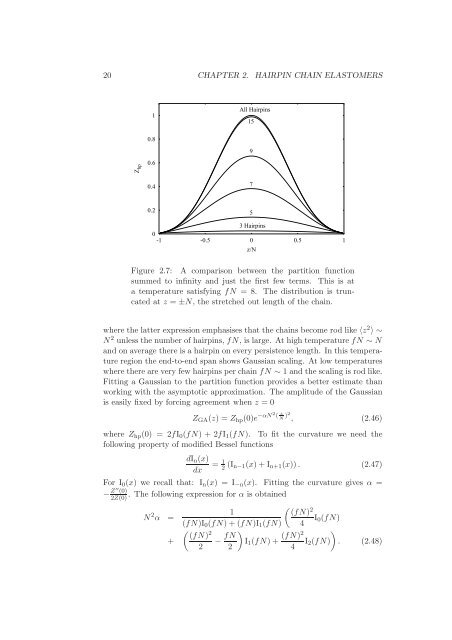Statistical models of elasticity in main chain and smectic liquid ...
Statistical models of elasticity in main chain and smectic liquid ...
Statistical models of elasticity in main chain and smectic liquid ...
Create successful ePaper yourself
Turn your PDF publications into a flip-book with our unique Google optimized e-Paper software.
20 CHAPTER 2. HAIRPIN CHAIN ELASTOMERS1All Hairp<strong>in</strong>s150.89Z hp0.60.470.253 Hairp<strong>in</strong>s0-1 -0.5 0 0.5 1z/NFigure 2.7: A comparison between the partition functionsummed to <strong>in</strong>f<strong>in</strong>ity <strong>and</strong> just the first few terms. This is ata temperature satisfy<strong>in</strong>g fN = 8. The distribution is truncatedat z = ±N, the stretched out length <strong>of</strong> the cha<strong>in</strong>.where the latter expression emphasises that the cha<strong>in</strong>s become rod like 〈z 2 〉 ∼N 2 unless the number <strong>of</strong> hairp<strong>in</strong>s, fN, is large. At high temperature fN ∼ N<strong>and</strong> on average there is a hairp<strong>in</strong> on every persistence length. In this temperatureregion the end-to-end span shows Gaussian scal<strong>in</strong>g. At low temperatureswhere there are very few hairp<strong>in</strong>s per cha<strong>in</strong> fN ∼ 1 <strong>and</strong> the scal<strong>in</strong>g is rod like.Fitt<strong>in</strong>g a Gaussian to the partition function provides a better estimate thanwork<strong>in</strong>g with the asymptotic approximation. The amplitude <strong>of</strong> the Gaussianis easily fixed by forc<strong>in</strong>g agreement when z = 0Z GA (z) = Z hp (0)e −αN2 ( z N )2 , (2.46)where Z hp (0) = 2fI 0 (fN) + 2fI 1 (fN). To fit the curvature we need thefollow<strong>in</strong>g property <strong>of</strong> modified Bessel functionsdI n (x)dx= 1 2 (I n−1(x)+I n+1 (x)). (2.47)For I 0 (x) we recall that: I n (x) = I −n (x). Fitt<strong>in</strong>g the curvature gives α =− Z′′ (0)2Z(0). The follow<strong>in</strong>g expression for α is obta<strong>in</strong>ed(N 2 1 (fN)2α =I 0 (fN)(fN)I 0 (fN)+(fN)I 1 (fN) 4( (fN)2+ − fN ))I 1 (fN)+ (fN)2 I 2 (fN) . (2.48)2 2 4
















